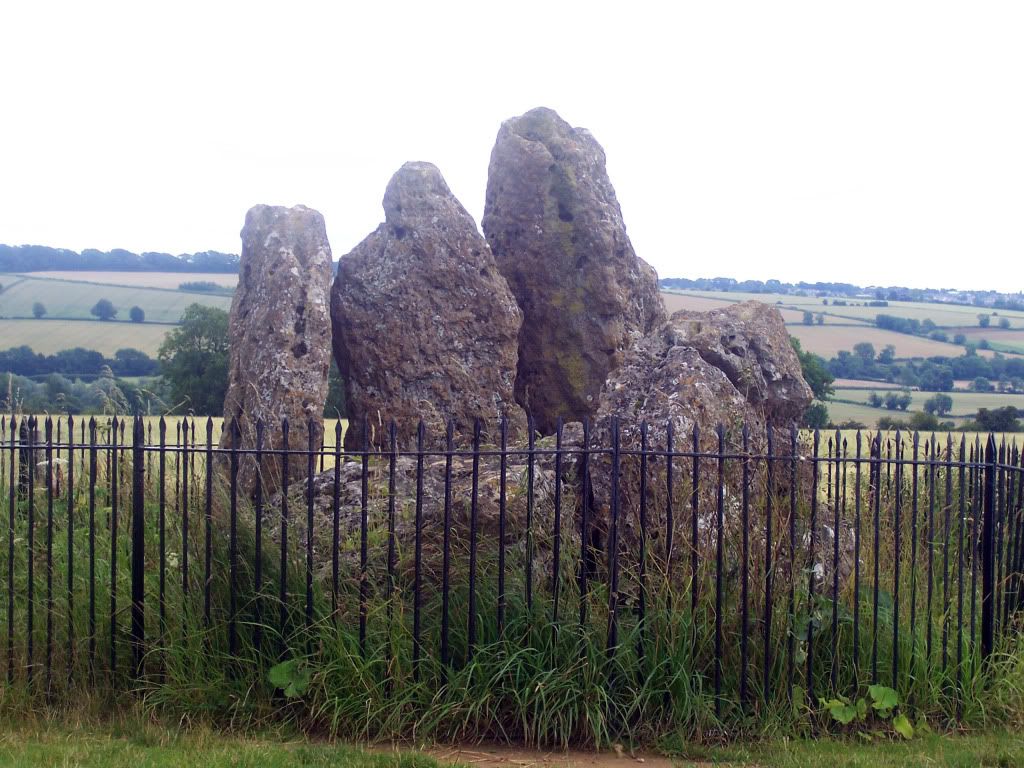
Unsolvedmystery - The Rollright Stones is the collective name for a group of enigmatic prehistoric monuments located next to an ancient ridgeway known as the Jurassic Way, on the border between the English counties of Oxfordshire and Warwickshire. The name ‘Rollright’ derives from Hrolla-landriht - ‘the land of Hrolla’.
The complex of monuments at the site consist of three main elements, the ‘King’s Men’ – a circle of about seventy stones, probably dating to around 2500 BC, the ‘King Stone’ – a solitary weathered monolith dated to 1792 BC, and the ‘Whispering Knights’, the remains of the burial chamber of a Middle to Late Neolithic portal dolmen, estimated to date to between 3800 and 3000 BC. There are also two further monuments, both almost completely destroyed, a round cairn (a roughly hemispherical burial mound constructed primarily of stones), and a ditched round barrow (a hemispherical burial mound).
Though not as grand and well preserved as the Avebury or Stonehenge ritual landscapes, the Rollright monuments possess their own unique atmosphere, and have attracted a wealth of supernatural folklore over the centuries involving witches, fairies, invading ‘Danes’, and the famous prophetess Mother Shipton. Indeed the monuments in the area seem to have attracted more legends than almost any other prehistoric site in England.
The earliest known belief about the stones, that they were petrified men, is first mentioned in Camden’s Britannia, written in Latin, in 1586, which states that ‘the common people usually call them Rolle-rick stones, and dreameth that they were sometimes men by a wonderful Metamorphosis turned into hard stones’.
Writing in the journal Folklore (September,1902) Percy Manning mentions perhaps the earliest appearance of a well known rhyme about the Rollright Stones, added as manuscript notes to his copy of Dr. R. Plot’s Natural History of Oxfordshire, (2nd edition. 1705):
Said the Danish General,
If Long Compton I cou’d see
Then King of England I shou’d be.
But reply’d the [" British " erased] Saxon General,
Then rise up Hill & stand fast Stone-
For King of England thou’lt be none.
By the mid nineteenth century the ‘Saxon General’ had been replaced by a witch. The witch confronts a conquering king at Rollright who is a few steps away from the crest of the ridge from where the village of Long Compton, lying in the valley below, is visible. According to the most complete version of the tale, collected by Arthur Evans from local people and published in Folklore in 1895, the witch stopped the King in his tracks by saying:
Seven long strides shalt thou take, and if Long Compton thou canst see, King of England thou shalt be.
Realizing that the village would certainly be visible from the edge of the hill the King strode forward shouting:
Stick, stock, stone, As King of England I shall be known!
Taking seven strides forward the King was suddenly confronted by a long mound of earth rising up magically before him (the mound of earth which still stands next to the King Stone) and blocking his view of the valley below. The witch then said:
As Long Compton thou canst not see
King of England thou shalt not be.
Rise up, stick, and stand still, stone,
For King of England thou shalt be none,
Thou and thy men hoar stones shall be
And I myself an eldern-tree.

And so the King and his army became the King Stone and King’s Men stone circle and the witch became an elder tree. The Whispering Knights were said to be a group of soldiers huddled together plotting treachery against the King when they were also turned to stone by the witch. The witch in this tale was sometimes identified as the mythical prophetess ‘Mother Shipton’, probably for no other reason than the proximity to Rollright of a village called Shipton-under-Wychwood.
As this folktale shows the stones have a connection in the popular imagination with witchcraft, though how far back this connection goes is not clear. Writing in the magazine 3rd Stone (Winter 2000/2001) folklorist Jennifer Westwood has shown that both the witch and the related elder tree elements of Rollright folklore are of comparatively recent date, there being no evidence for either motif earlier than the mid nineteenth century in stories from the site.


